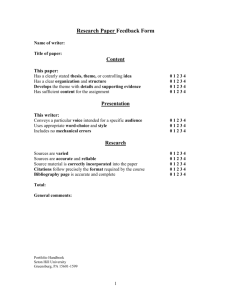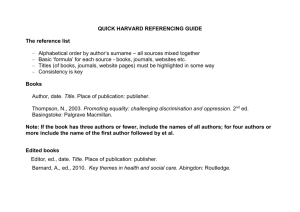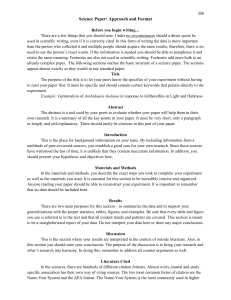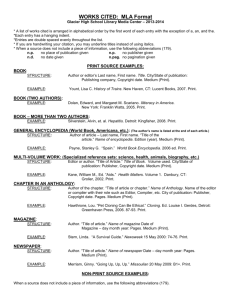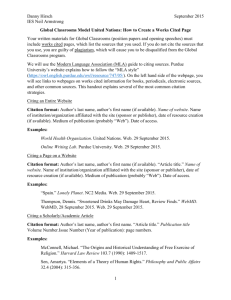MLA Cheat Sheet for a Works Cited Page
advertisement
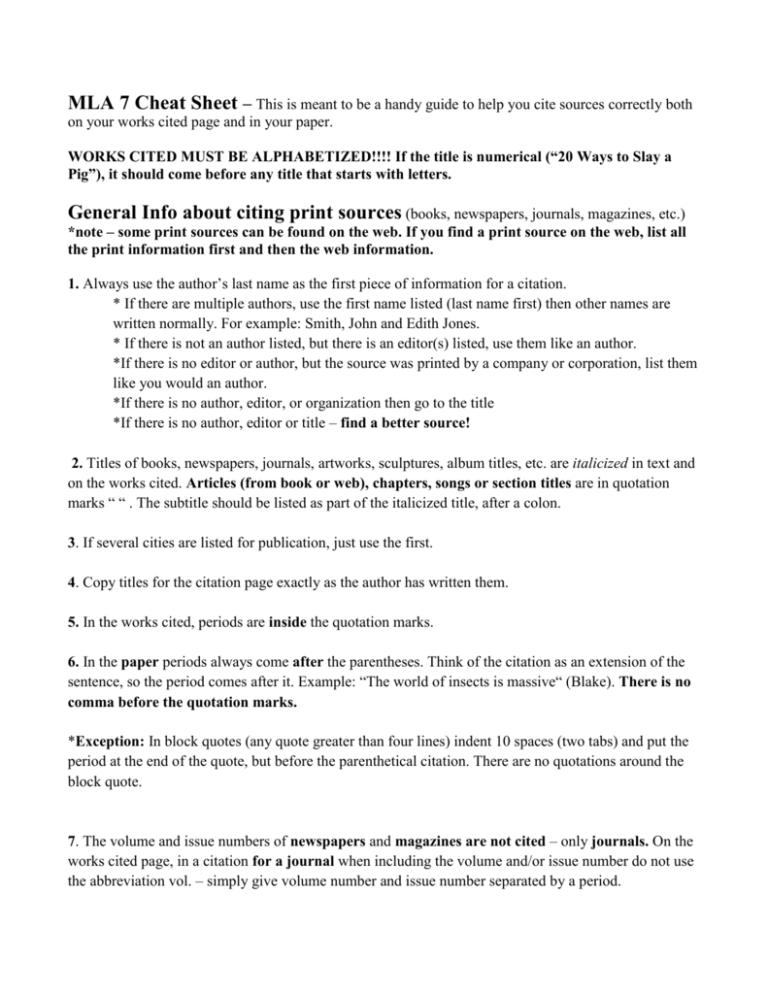
MLA 7 Cheat Sheet – This is meant to be a handy guide to help you cite sources correctly both on your works cited page and in your paper. WORKS CITED MUST BE ALPHABETIZED!!!! If the title is numerical (“20 Ways to Slay a Pig”), it should come before any title that starts with letters. General Info about citing print sources (books, newspapers, journals, magazines, etc.) *note – some print sources can be found on the web. If you find a print source on the web, list all the print information first and then the web information. 1. Always use the author’s last name as the first piece of information for a citation. * If there are multiple authors, use the first name listed (last name first) then other names are written normally. For example: Smith, John and Edith Jones. * If there is not an author listed, but there is an editor(s) listed, use them like an author. *If there is no editor or author, but the source was printed by a company or corporation, list them like you would an author. *If there is no author, editor, or organization then go to the title *If there is no author, editor or title – find a better source! 2. Titles of books, newspapers, journals, artworks, sculptures, album titles, etc. are italicized in text and on the works cited. Articles (from book or web), chapters, songs or section titles are in quotation marks “ “ . The subtitle should be listed as part of the italicized title, after a colon. 3. If several cities are listed for publication, just use the first. 4. Copy titles for the citation page exactly as the author has written them. 5. In the works cited, periods are inside the quotation marks. 6. In the paper periods always come after the parentheses. Think of the citation as an extension of the sentence, so the period comes after it. Example: “The world of insects is massive“ (Blake). There is no comma before the quotation marks. *Exception: In block quotes (any quote greater than four lines) indent 10 spaces (two tabs) and put the period at the end of the quote, but before the parenthetical citation. There are no quotations around the block quote. 7. The volume and issue numbers of newspapers and magazines are not cited – only journals. On the works cited page, in a citation for a journal when including the volume and/or issue number do not use the abbreviation vol. – simply give volume number and issue number separated by a period. 8. In the Works Cited, when citing authors/editors do not include professional titles such as: Dr. PhD. etc. Or, Mr., Mrs. or Ms. Do include titles such as: Jr., III., etc. Example: Smith, John, Jr. 9. Page numbers are included in the in text citation, but are only on the Works Cited page if the source is a print source and more than one page. On Works Cited, only the range of page numbers is included. 10. If a book or journal has an author, but also editors, list the author - last name first, then article/chapter/book titles, then Ed. and the editor’s name. Example: Allende, Isabel. “Toad’s Mouth.” A Hammock beneath the Mangoes: Stories from Latin America. Ed. Thomas Colchie. New York: Plume, 1992. 83-88. Print. 11. If the source has only editors and no authors (like a reference book or anthology) do the editor’s name (last name first) and ed. after the name. General Info for citing web or database sources 1. If you find a source on the web, that was printed at one time, include all the publication information and then the web information. 2. For citing a web page *note – if you cannot find version or publisher just move onto the next thing. *give the author, compiler, director, editor, narrator or performer first. * Title of the webpage (article) is in quotations marks * Title of the website is in italics (if the website and webpage are the same title, still list both) *version or edition used *Publisher or sponsor of the site – if not available use N.p. *Either Date of Publication (day month year) or date of last update - if not available use n.d. *Then address the medium of the source: Web. *Date of access (day month year) ** Only attach the URL if it is required by your teacher – or if you think it will be helpful to find the source later. Enclose it in “caret” < >. 1. Basic Format for a Book: Last name, First name. Title. City of publication: Publisher, Date. (If pg #s are appropriate – they go here). Print. 2. Two or Three Authors of a Book Last name, First name, First name, Last name, and First name Last name. Title. City of publication: Publisher, Date. (If pg #s are appropriate – they go here). Print. Ex: Smith, Alan, Betsy Ross, and Ross Periwinkle. We are Tired: We are Teachers. Narnia: Lion’s Press, 1492. 67-98. Print. 3. A book with Editors (multiple Authors) Last name, First name, and First name Last name, eds. Title. City: Publisher, Date. (If pg #s are appropriate – they go here). Print. 4. Book in several volumes: Last name, First name. Title. Volume #. City: Publisher, Date. (If pg #s are appropriate – they go here). Print. 5. Corporate Author Corporation (e.g. Bank of Boston). Title. City: Publisher, Date. Print. 6. Work in an Anthology Last name, First name. “Title in Quotations.” Title of Anthology. Ed. First Name last name. City: Publisher, Date. Page numbers. Print. 7. Article in a Weekly Magazine Last name, First name. “Title of the Article in Quotations.” Title of Magazine. Date (e.g. 17 Dec.). Year: page numbers. Print. 8. Article in a Monthly Magazine Last name, First name. “Title of the Article in Quotations.” Title of Magazine . Month (e.g. Feb.). Year: page numbers. Print. 9. Article in an Academic Journal Last name, First name. “Title of Article.” Title of Journal. volume #. Issue #. Date. Page numbers. Print. 10. For Internet (basic free web) Last name, First name. “Title of Webpage/article.” Title of Website. Sponsor of Website (if none – N.p.), Date of Last Update/Publication (if none n.d.). Web. Date of access (day month year). 11. For Online Databases and Academic Journals Last name, First name. “Title of Article.” Title of Publication. Editor. Date Published: Page Numbers (if given). Database Title. Title of Online Service. Library where retrieved. Web. Date accessed *Most databases provide the citation so you can cut and paste – but if in doubt ask your teacher!!! 12. Interview (If YOU the student conducts the interview – ask you teacher how to cite interviews that have been published) Last name, First name (of person who was interviewed). (Kind of interview – either Personal interview, or Telephone interview). Date of interview (day month year). EXTRA: 1. You need to include page numbers IN THE PAPER – IN THE PARENTHESES Ex. (Balke 24). 2. There are no commas between the author and the page number. IF you have more than one page number use dashes. Ex. (Neilson 384-397). 3. You MUST tell the READER where you got your INFORMATION. There are two main ways to do this: 1. Before you quote or paraphrase your information introduce the author of your source. Example: In Marvin Stampel’s book, To Flirt with Reason he states, “all men are created equal until they start to use their brain” (52) and he maintains that people in general should be careful about what they believe from outside sources, such as the media. 2. After the quote. Example: In 1666 a severe case of the Black Plague swept across England and killed over three quarters of the population. The Plague was “the single most devastating event in Great Britain’s history, before or since” (Mauler 73). WHAT IS IN WORKS CITED MUST BE IN PAPER – VICE VERSA! Primary Sources: -original documents -first hand knowledge/experiance Secondary Sources: Analyses articles and books about political issues, historical events, scientific debates, or literary works.

